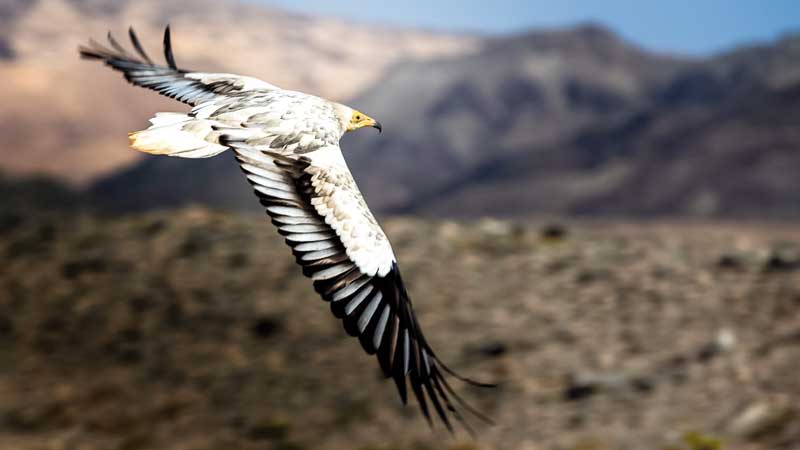


“When vultures surround you,” says an African proverb, “try not to die.” The Egyptian Vulture (Neophron Percnopterus) has a somewhat checkered reputation, which is surely attributed to its other common name as the ‘White Scavenger’ vulture and suffers too from the others in its ornithological group having names of comparative elegance and gravitas such as the kites, hawks, and eagles.
A recent visit to Masirah Island saw us locate what appeared to be a rather sedentary trio of the species near the beautiful Biyad Beach, 20 kilometres South of the swanky Masirah Island Resort on the sandy Eastern coastline. They appeared to spend much of their day watching us, though at sunrise each day obviously went searching for food as they were often ‘on the wing’ as we arrived for our early morning fishing session, taking advantage of the coolest part of the day; both they and us!
Our local expert, Darrel Pinto, explained that though most of the birds on Masirah Island tend to migrate between Africa and India, the Egyptian Vulture, being bigger and heavier, tends to find and make their home where their needs are largely met, and this is clearly true of this small ‘family.’ Jose Donazar is widely acknowledged as an expert on the species, and he (et al) writes that once the male has found and mated with a partner, he will stay with her to ensure the safety of the resultant chicks. Ironically, another male, may assist with the ‘minding,’ duties as a ‘friend,’ no more than that.
Once the chicks hatch after around six weeks and leave the nest as fledglings after another fourteen to sixteen weeks, returning to the nest for another four to six weeks before taking their leave on a ‘rite of passage,’ flight which may take them as far as 500 kms again according to Donazar et al, resting for a year in Africa before returning to their birthplace. Being young and strong by now, their next task is to seek out a mate and in their third to fifth years, when their distinctive plumage achieves its full colour, a partner is their main priority.
Renowned for feeding mainly on carrion, such as roadkill, or beached fish, the Egyptian Vultures are not averse to seeking perished lizards, mice, birds, and eggs. The Greek philosopher wrote almost in their praise as ‘righteous creatures,’ “not attacking even the smallest living creature.” These magnificent predators are also very much opportunist feeders, though in the seaside environment their shyness near humans means they will often be ‘beaten to the punch’ by the ubiquitous seagulls.
The Environmental Society of Oman has identified the species as “the region’s most threatened, and since 2012 has actively studied the habits and movements of the birds, with gratifying results through surveys and tracking. It is a positive sign that although numbers globally are decreasing, these stern-faced, humourless looking relics of bygone ages appear to be thriving in the Sultanate, at least for now.
Although change is constant, in nature, the vulture may never become an eagle, yet still deserves its day in the Sun, so to speak, and not simply be the object of derision, horror and dread. In the same way that not every Hollywood actor is handsome, so the vulture reminds one easily of the craggy, yet thoroughly robust Sean Bean of Game of Thrones, not terribly ‘flash,’ but unforgettable.
By Ray Petersen
Photos by Lena Petersen
Oman Observer is now on the WhatsApp channel. Click here



